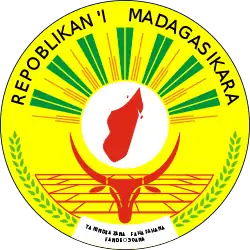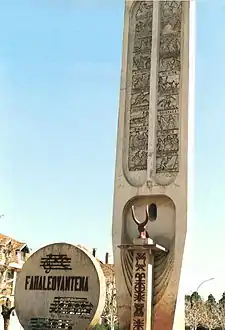Ry Tanindrazanay malala ô!
Ry Tanindrazanay malala ô! is the national anthem of Madagascar.[2] The lyrics were written by Pasteur Rahajason and the music by Norbert Raharisoa. It is similar to a march and was strongly influenced by European music and the French colonial education system[2][3] It is often played by Malagasy musicians on the accordion.[2] The anthem was officially adopted on April 27, 1959 by the parliament of Madagascar[4] prior to the official granting of independence on 26 June 1960.[5] Philibert Tsiranana was Prime Minister of Madagascar during the creation of the anthem and Michel Debré was the French Prime Minister during this time.[6] The main focus of the anthem is love of the land, as well as thankfulness to God and an appeal to unity and loyalty under the nation.
| English: Oh, Our Beloved Father Land | |
|---|---|
 The Seal of Madagascar. | |
National anthem of | |
| Lyrics | Pasteur Rahajason, 1958 |
| Music | Norbert Raharisoa, 1958 |
| Adopted | 27 April 1959[1] |
| Audio sample | |
"Ry Tanindrazanay malala ô!" (instrumental)
| |
Writers and composers
"Pastuer" (Pastor) Rahajason
"Pastor" Rahajason is credited with writing the national anthem of Madagascar.[4] He was a priest born in 1897 and died in 1971. He was influenced by the French colonial education system, the aim of which was to assimilate the colonized people and was part of the broader civilizing mission.[3] This system was designed to orient local Malagasy populations towards the French colonial project, promoting strong ties to the French language, as well as French civilization, values, and cultural preferences.[3] The schools were often associated with various missionary organizations, imparting a strong religious education overtone, also accounting for Rahajason's exposure to Christianity and his subsequent decision to become a pastor.[3]
Norbert Raharisoa
Norbert Raharisoa is credited with composing the national anthem of Madagascar.[4] Raharisoa was also a music teacher and professor.[4] He was born in 1914 and died in 1963, shortly following the adoption of his composition. He was honoured for his contributions to Malagasy culture by being featured on the 40 franc postage stamp in 1967. Like his colleague Rahajason, Norbert Raharisoa was raised under the French colonial education system, which explains the colonial influence on the anthem.[3]
Other influential people
Philibert Tsiranana, the Prime Minister of Madagascar during the independence talks with France, was content to remain within the broader influence of the French, including the franc zone.[6] He wanted to ask for an independent ability to conduct diplomatic relations, allowing France to continue its role in other aspects of governance such as defense.[6]
Michel Debré was the French Prime Minister during this time.[6]
March (format)
The anthem is written as a European-style march, consistent with many national anthems around the world.[2] The march is traditionally a military style, with a strong and even beat, originally meant to help troops "march" in step while traveling.[7]
The anthem betrays its colonial influence through the general absence of local musical styles and instrument types. Ron Emoff, professor of music and anthropology at OSU Newark, notes that the anthem is not played in the vakondra-zana style, which is the style of the ancestors' music, also known as a form of traditional music.[2] Emoff also notes that the anthem is usually not played on the local instrument, the valiha[2]. This is because the anthem replicates the same essential ingredients that European hymns use, which are themselves based on old religious and nationalistic hymns.[8]
History of adoption
The national anthem of Madagascar was officially adopted on April 27, 1959, approximately one year before Madagascar achieved independence from the French, on June 26, 1960.[9] The song was originally written in French and Malagasy, an Austronesian language,[8] indicating both the influence of the French colonizers and the prominence of Austronesian immigration to Madagascar.
Anthems are meant to be hymns to the nation, celebrating important national traditions, goals, and histories and Madagascar's anthem follows this tradition well.[8] They are meant to create a strong sense of national unity and nationalism, and in nations like Madagascar, they are designed to supersede ethnic affiliations.[8]
Researcher Igor Cusack identified several themes under which national anthems generally fall: calls to awake, arise, or work for future progress; praise for what's already there; and/ or thanks to God.[5] Cusack defines anthems as essentially praise hymns to God, the nation, or a parental figure, in keeping with the European origin of anthems as hymns.[5] Writing about Madagascar, Cusack explains that it was influenced by its French colonial masters, and featured the themes: blessed by God, God save our land/people, and a nonspecific love of their beloved land.[5]
History of Madagascar
The anthem is officially written in both French (the colonial language) and Malagasy (the predominant local Austronesian language). This is because prior to Madagascar being conquered by the French in 1896, the island was already home to many different people groups, beginning with the arrival of Austronesians in AD 350.[9] African migrants came from AD 1000 and onwards, as well as other smaller groups,[9] making Madagascar a very diverse nation and explaining the emphasis in the anthem of uniting as a nation based on the beauty of the land rather than a specific ethnic identity. In all, the people of Madagascar were influenced by Austronesian, French, Indian, Arab, and African cultural and religious practices.[9]
Although the independence movement in Madagascar can be traced back to the nationalist attacks against the French in late March 1947, it is officially credited to the successful referendum vote in 1958 and the founding of the Malagasy Republic on October 14, 1958.[10] They were officially granted independence from France on June 20, 1960 and became known as the Republic of Madagascar.[11]
Analysis of lyrics
Based on the themes provided by Igor Cusack, the Madagascar anthem strongly demonstrates elements of "blessed by God", "God save our land/people", and a "love of their beloved land".[5]
First Stanza
| English Approximation | Analysis | |
|---|---|---|
|
This stanza focuses on an all-encompassing love of the nation and the land.
It opens with a collective remembrance and affection for the past and the ways of the past as represented by the ancestors and closes with a nationalistic promise of fidelity and loyalty to the nation. |
Chorus
| English Approximation | Analysis | |
|---|---|---|
|
The chorus is a prayer to the Creator, who is most likely the Christian God, based on
Madagascar's French colonial legacy. It connects the present once again to the past of the ancestors and asks a general blessing of joy and happiness on the country and its people. |
Second Stanza
| English Approximation | Analysis | |
|---|---|---|
|
This stanza is a response to the beauty of Madagascar and the love of its citizens
have for it. They affirm their connection to the nation and their desire to serve the nation with body, heart and soul. |
Third Stanza
| English Approximation | Analysis | |
|---|---|---|
|
This final stanza reaffirms the love the Malagasy have for their beloved nation
and ask blessings on it and its people by again referencing the Christian God. |

Full lyrics
| Malagasy lyrics | French translation | Approximate English translation |
|---|---|---|
| First stanza | ||
|
Ry Tanindrazanay malala ô! |
Ô Chère Terre de nos ancêtres |
Oh, beloved land of our ancestors! |
| Chorus (2X in the end): | ||
|
Tahionao ry Zanahary |
Benit, ô Créateur, |
Bless, oh Creator, |
| Second stanza | ||
|
Ry Tanindrazanay malala ô! |
Ô Terre de nos ancêtres chérie |
Oh beloved land of our ancestors! |
| Third stanza | ||
|
Ry Tanindrazanay malala ô! |
Ô Terre de nos ancêtres chérie |
Oh beloved land of our ancestors! |
References
- "Madagascar". Nationalanthems. David Kendall. Retrieved 20 September 2012.
- Ron., Emoff (2002). Recollecting from the past : musical practice and spirit possession on the east coast of Madagascar. Middletown, Conn.: Wesleyan University Press. ISBN 9780819565006. OCLC 47922731.
- Rosnes, Ellen Vea (2017-11-02). "Christianisation, Frenchification and Malgachisation: mission education during war and rebellion in French colonial Madagascar in the 1940s". History of Education. 46 (6): 749–750. doi:10.1080/0046760x.2017.1368723. ISSN 0046-760X. S2CID 148786962.
- "Madagascar". nationalanthems.info. 2013-02-16. Retrieved 2017-11-16.
- Cusack, Igor (2005). "Beat the drums, the red Lion has roared". Journal of African Cultural Studies. 17 (2): 235, 238, 244, 248. doi:10.1080/13696850500448337. S2CID 163149597.
- "Madagascar Begins Independence Negotiations". Africa Report. January 1, 1960.
- "march | music". Encyclopedia Britannica. Retrieved 2017-11-27.
- Lengyel, Emil (October 7, 1962). "New Nations Sing Out: The creation of national anthems for ex-colonials raises language problems". New York Times.
- "The World Factbook — Central Intelligence Agency". www.cia.gov. Retrieved 2017-11-20.
- Späth, Mareike; Rajaonarison, Helihanta (2013). "National days commemoration and celebration: remembering 1947 and 1960 in Madagascar". Anthropology Southern Africa. 36 (1&2): 52. doi:10.1080/23323256.2013.11500042. S2CID 146615393.
- Colburn, Lisa (2001). "Madagascar". In Ember, Carol and Melvin (ed.). Countries and Their Cultures. 3. New York: Macmillan Reference USA. pp. 1342–44, 1352. ISBN 978-0-02-864950-4.
External links
| Wikimedia Commons has media related to National anthem of Madagascar. |